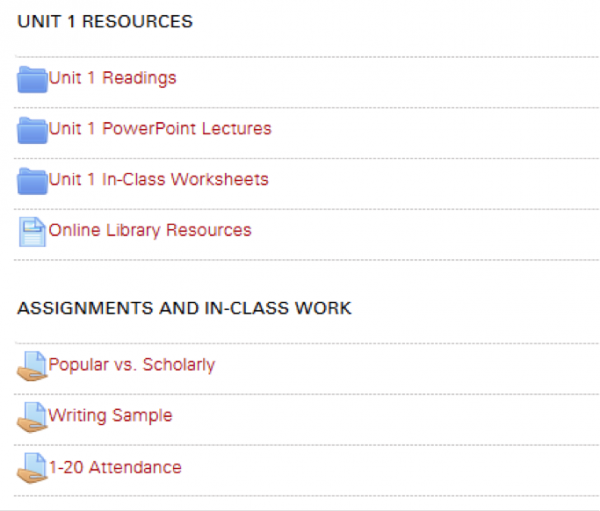Senior Lecturer Kate Lavia-Bagley is our guest blogger for March. Kate has been in the First-Year Writing Program for ten years and teaches courses in face-to-face, hybrid, and online formats.
While convenience and scheduling conflicts are key reasons why typically developing students take online classes, students with disabilities are turning to virtual classrooms to help contend with attendance issues related to health, transportation concerns, or social anxiety. Regardless of the reason, designing a more inclusive classroom can help all your students succeed. Here are some key strategies you can implement into your online classes.
SETTING UP MOODLE
- Prioritize accommodations placement. If you’re like me, information about students with disabilities is listed at the end of your syllabus, directly behind the academic integrity policy. Moving this statement to the beginning of your syllabus helps to let your students know that meeting their needs is important to you.
- Provide checklists in Moodle to help students who have difficulty prioritizing tasks understand what steps they need to take in order to be successful in your classroom. You can change the settings so that students cannot have access to a new activity until they have completed the previous one.
- Organize your materials logically with clear course headings and labels. Here is a sample of the resources I include at the end of my daily schedule for each unit. By grouping and labeling them according to content, it makes it easier for all students to find the materials they need quickly and easily.

Teaching to a Student’s Strengths
Neuroscience reveals that there are three major areas of the brain’s pathways that come into play when learning new tasks: recognition networks, strategic networks, and affective networks.
Recognition Networks
Recognition networks relate to how students gather and categorize information, in other words, what they learn from us. Our task as teachers is to ensure that we are presenting information in as many different formats as possible in order to ensure that all students are able to understand the content of class regardless of any disabilities they may have.
Some ways to provide better access to learning materials are to:
- Offer notes, PowerPoints, charts, and even discussion questions on Moodle page
- Provide transcripts to any videos
- Assign online discussion forums
- Record lectures using My Media and provide transcripts
- Use synchronous resources to communicate with students, e.g. Skype (can mean access to us)
Strategic Networks
Strategic networks relate to how students perform and plan activities, or how they express their ideas, in other words, how they demonstrate what they know. Here, our task is to ensure that we are giving students the opportunity to prove their knowledge of class content in a variety of ways since not all students are skilled in the same areas. This can be tricky to do in a 101 classroom where the major assignments have to be writing based; however, we can offer low stakes assignments that offer students the opportunity to shine in other areas.
Some ways to vary our assessment of students are to:
- Include multi-modal projects
- Ask students to participate in small and large group discussions online
You can also vary the way you provide assessment feedback to your students by using Jing or PoodL, online screen capturing technology that allows you to record images of the student’s work and your verbal comments at the same time.
Affective Networks
Affective networks in the brain pertain to how students get involved with the material and stay engaged throughout the learning process. Our goal then is to give students multiple opportunities to engage with class content and to participate in course goals.
Some ways to keep our students engaged are to:
- Use videos, podcasts, music, images, blogs
- Assign roles in discussion assignments
- Have students lead discussions
- Offer choices when possible
By providing better access to materials, assessing student work through a variety of methods, and ensuring students stay involved in class content, we can give each student in our class an opportunity for success.
“Everybody is a genius. But if you judge a fish by its ability to climb a tree, it will live its whole life believing that it is stupid.” ~Einstein
Sources: udlcenter.org

